Plant phys exam 2
1/84
There's no tags or description
Looks like no tags are added yet.
Name | Mastery | Learn | Test | Matching | Spaced |
|---|
No study sessions yet.
85 Terms
When do new plant cell walls arise?
during cytokinesis
What is the position of a new plant cell wall determined by?
pre-prophase band of microtubules
Define pro-prophase
before the mitotic spindle forms but after the interphase microtubules have broken down (unique structure to plants)
band is completely broken down at the end of prophase… remembers is orientation during cytokinesis
How is the plane of cell division determined in animal cells?
determined by the position of the mitotic spindle (perpendicular)
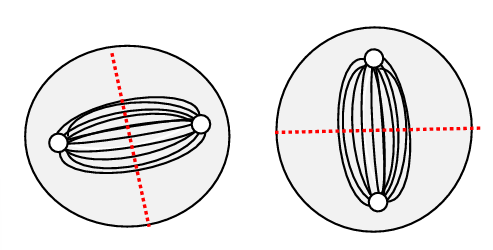
How do new plant cell walls arise?
- cell plate= developing cell wall
- cell plate formed inside to outside in late anaphase/early telophase
cell plate organized by the phragmoplast
What is the phragmoplast?
unique to plant cells
microtubules, ER, vesicles
What forms the plasmodesma?
tubular channels of cytoplasm and ER
connect adjacent plant cells
provides cytoplasmic continuity
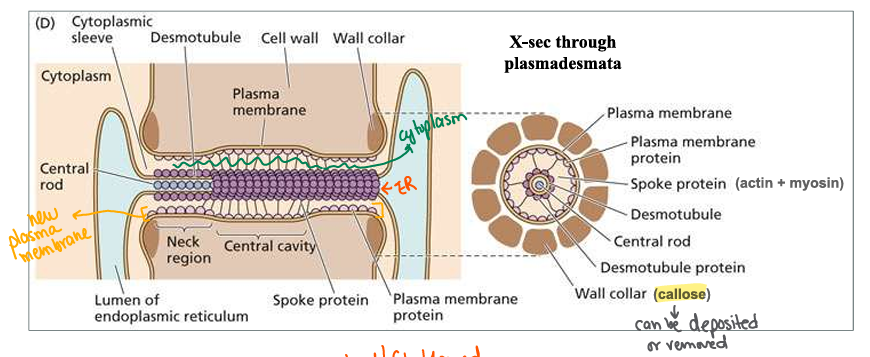
Ho w do adjacent cells communicate?
transcription factors
gene transcripts (mRNAs)
hormones
proteins
Plant cell wall composition
cellulose
hemicellulose
pectin
proteins
some also have- waxes/suberin/cutin and lignin
VARIABLE
What system is a key player in cell wall formation?
/
endomembrane system
proteins, hemicellulose/pectins, and cellulose
What is the middle lamella?
outermost layer of plant cell wall
made of carbohydrates= pectin
glue adjacent plant cells together
synthesized/ secreted during cell plate formation
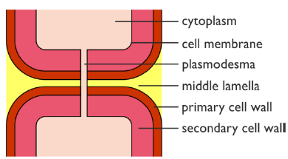
What is the primary cell wall?
synthesized after middle lamella
made of carbohydrates and proteins
thin and flexible (rigid AND extensible)
Explain the components of the primary cell wall
cellulose: structural backbone (linear polymer); H+ bonds to form polymers to form higher order= cellulose microfibrils
What is the benefit of H+ bonding within cellulose polymers?
produces a highly ordered structure and high tensile strength, and resistant to chemical attack
How are cellulose microfibrils formed?
ring structure with 6 particles (particle rosette)
each particle synthesized in ER, processed through the golgi and delivered to and incorporated into plasma membrane
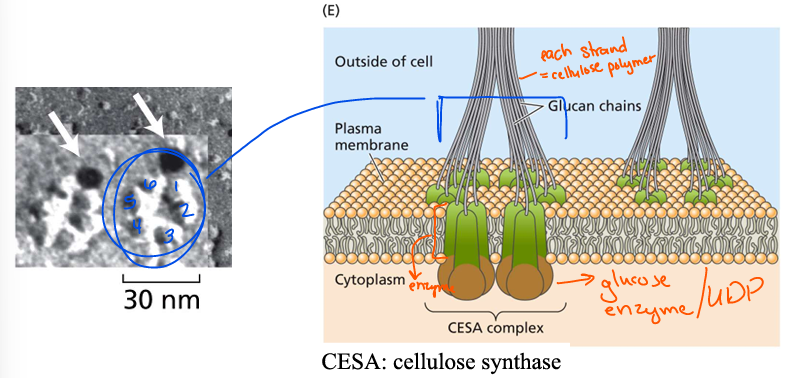
In plants, how many cellulose synthases enzymes are predicted to be present in each rosette?
3 cellulose synthase enzymes
What happens when cellulose microfibrils form?
1- polysaccharides (hemicelluloses/pectin) are synthesized in the GOLGI by membrane bound enzymes
2- transported to cell wall to be exocytosis
3- form a meshwork around the cellulose microfibrils
Describe hemicelluloses and pectins
composed of many different carbohydrates
each cell types has a unique combination
large complex polymers
Characteristics of hemicellulose
Beta 1,4 sugar backbone with many short side chains
diverse and named for sugars present
bind VERY tightly to cell wall
H bonds to microfibrils
hemicellulose- spaces apart microfibrils; resists compression forces
hydrophilic= help resist compression forces
What is the significance of the 1,4 sugar backbone in hemicelluloses?
produces a very flat/linear polymer (ribbon-like)
side branches prevent aggregation with each other
What are the characteristics of pectin?
hydrated polymers
resist compression forces, provide charged surface for cell-cell adhesion
diverse but lots of acidic sugars
Carboxyl group characteristics at pH variations
pH of 7= COO- form is predominate/unprotonated (charged)… less H+ = more interactions; creates a stiffer gel around the other wall components
pH of 5.5= protonated; more H+= less interactions; salt bridges are released… helps loosen wall for expansion
What happens when cellulose microfibrils form?
proteins are also added to cell wall
synthesized in ER/modified in Golgi
transported to wall in vesicles and exocytosed
What are the functional proteins found in cell walls?
oxidative enzymes- peroxidases AND expansins
hydrolytic enzymes- pectinases/cellulases/hemicellulases AND chitinases
What do the oxidative enzymes do?
peroxidase- strengthens, rigidifies cell walls
expansins- requires low pH, catalyzes cell wall growth/expansion
What do the hydrolytic enzymes do?
pectinases/cellulases/hemicellulases- weaken wall… allows expansion to occur
chitinases- defense against insects… weakens exoskeleton of fungi/insects
What is the purpose of structural proteins in plant cell walls?
rigidify/strengthen cell walls
vary in abundance, by cell type, maturation state of cell
What materials forms bonds within the plant wall?
polysaccharides and proteins (high lysine content)
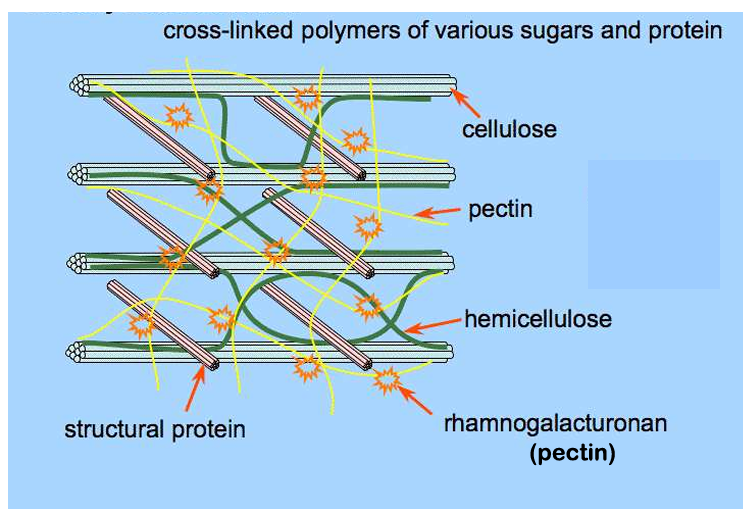
Plant cell wall structure
Secondary cell wall characteristics
produced last/internally and after cell elongation/expansion
primarily composed of cellulose, hemicelluloses and lignin
very thick, rigid
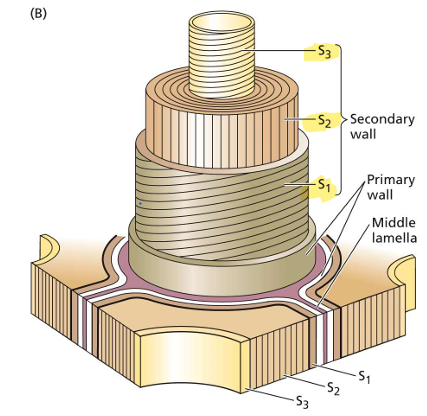
Orientations of cell wall
provides MAXIMUM strength to cell wall
Lignin characteristics
synthesized from 3 different precursors in cytosol (H, G, or S lignin)
transported into cell wall via ABC transporters (hydrophobic substances)
How do cellulose microfibrils and lignin impact the secondary cell wall?
impart great strength against gravity, rigidity, and hydrophobicity
physical block to pathogens (attack/wounding by pathogens0
chemically resistant to breakdown
undigestible- not nutritional value
How do animal cells drive changes in cell shape/movement?
they use the cytoskeleton- microfilaments and myosin
How do plant cells drive changes in cell shape/movement?
by loosening cell wall & turgor pressure to change shape/expand
What is the acid growth hypothesis?
a mechanism for cell wall loosening and expansion
auxin promotes elongation of shoots/roots
auxin rapidly stimulates elongation in shoots
maximal growth in 30-60mins… suggests transcription of genes might play a role
most cell elongation occurs close to meristem
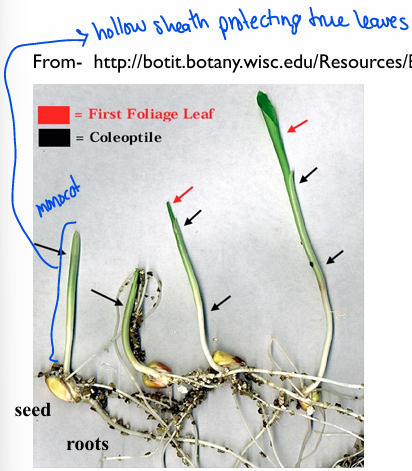
What is coleoptile?
in monocots; hollow cylindrical sheath
surrounds/protects young leaves during germination
What does the apical hook do during germination?
protects apical meristem in dicots
suggests acidification is needed in elongation
What are the roles of Auxin in cell expansion/growth?
promotes H+ efflux from cell
prevents H+ pumps from being endocytosed into cytoplasm
promotes transcription of new H+ pumps/K+ channels/ expansin
How does auxin promote transcription?
promotes degradation of the repressor Aux/IAA… removal allows transcriptional activator to dimerize/promote transcription
How does auxin mediate Aux/IAA protein degradation?
Auxin promotes ubiquitin (UB) mediated protein degradation
ubiquitin is attached to a protein marking it for degradation in the cytoplasm
What is required for ubiquitin mediated degradation?
3 enzymes: E1, E2, E3 enzymes (activating, conjugating, ligase
proteins must be at least 4 UB molecules to be targeted/degraded
most variable enzyme is E3… moves to target (several different kinds)
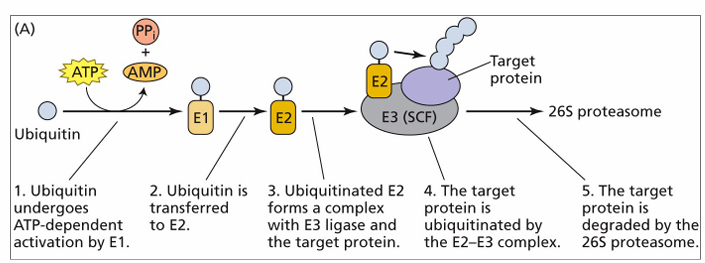
What are the names for the proteins associated with auxin degradation?
S = Skp1 (ASK1-arabidopsis skip1)
C = cul1 protein
F = F-box protein… conserved region (very diverse)
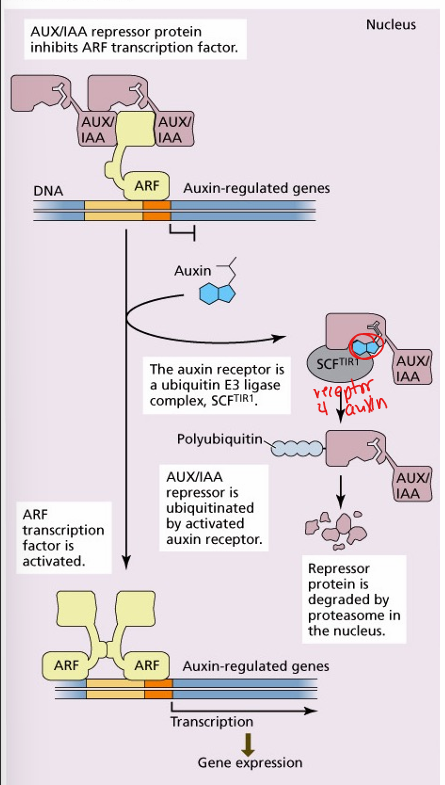
What mediates cell wall loosening?
expansin protein… breaks bonds between cellulose microfibrils and hemicelluloses
What happens during the cessation of growth/expansion?
decrease acidification of cell wall
increase the # linkages within wall
form secondary call wall and add lignin (irreversible)
What is cell shape/direction of cell expansion determined by?
orientation of cellulose microfibrils
growth is perpendicular to orientation of the cellulose microfibrils
** newest cellulose microfibrils determine direction of growth
Tip growth is an example of…
polarized growth and cell expansion
all growth occurs near the tip of the cell… loosening of cell wall is localized to tip
What determines orientation of cellulose microfibrils?
cortical microtubules… just under plasma membrane
its orientation parallels the cellulose microfibril orientation
What is the role of the cortical microtubular?
guidance tracts (propelled through plasma membrane)
directly associated with microtubules (motor protein walks along)
Cell expansion/elongation depends on # of interacting factors:
Position within plant and plant body (pressure forces by other cells)
Cell type and genetics- epidermal vs vessel
environmental influences- light vs dark
hormonal influences in plants
What do plant hormones do for plants?
important for efficient communication between cells, tissues, and organs
synthesized in one area of plant- transported to another area to invoke response (typically vascular tissues)
Synthesis and transport of Auxins
synthesized in actively dividing cells (meristems)
transported in parenchyma cells in xylem tissues
transport is ‘polarized’ (directional)
What are two forms of auxin?
protonated (IAAH) neutral
unprotonated (IAA-) charged… leaves through transport proteins
** pH determines ratio of forms
PIN proteins are…
efflux carriers
# of different PINS in plants, distributed among different tissues
How does auxin promote formation of lateral adventitious roots
Auxin moves down root functioning as morphogen
At specific concentration the outermost layer of the vascular tissues (pericycle) begin dividing
How does auxin promote root hair formation
Auxin is redirected back towards shoot in epidermal/cortical cells
requires specific concentration
regulates gene transcription
How does auxin promote patterning during embryogenesis
cotyledon (embryonic leaves) formation during embryogenesis
PIN1 is relocalized to create changes in auxin flow
How does auxin promotes vascular tissue differentiation
xylem differentiation during secondary growth
How does auxin determines position of new floral primordia in reproductive meristems
auxin is localized to where new floral primordia arise
once initiated-auxin concentrations decrease
primordia eventually produce flowers
How are adventitious roots form by auxin?
auxin collects/concentrates at base of stem… promotes root formation
adventitious= forms in unusual place (produced for structural support)
How is auxin involved in apical dominance
Inhibits growth of the youngest axillary buds
How does auxin mediate tropic curvature
requires asymmetric cell elongation across the organ
Auxin promotes cell elongation in shoots but inhibits cell elongation in roots
** tropism- positive and negative
Gravitropism
roots- positive gravitropic response (towards gravity)
shoots- negative gravitropic response (away from gravity)
What is the starch statolith hypothesis?
perception of gravity is due to the movement of statoliths(heavy, starch storing plastids) in statocytes (gravity sensing cells)
change is statolith position triggers gravitropic response (starts with signal cascade)
Auxin is required for…
cell division (with cytokinin)
** can’t do cell cycle without
Auxin promotes…
fruit formation (in part by stimulating cell division and cell expansion)
How does auxin regulate so many processes during development?
partly by degrading repressor proteins and regulating differential gene expression
family of 22 ARF’s
24 different AUX/IAA proteins interact with the ARF’s
development is regulated by differential gene expression
Describe cytokinin
Discovered in search for factors that promote cell division
kinetin was first identified cytokinin (breakdown product of autoclaved herring sperm DNA
ones that are naturally occurring are derivatives of adenine
What is a major site of cytokinin synthesis?
the root of plant
many tissues can synthesize cytokinin (ovules, immature seeds)
What are cytokinin functions?
help regulate cell cycle along with auxin
help regulate shoot and root formation in callus along with auxin
callus- ball of undifferentiated cells
causes ‘greening’ of plant
delay leaf senescence (death process)
What is cytokinin required for?
normal activity of SAM and RAM
promotes cell division in shoot
repress cell division activity of the root
Hoe does cytokinin support apical dominance?
keeping cytokinin concentration low by degrading biosynthesis
IPT is the first enzyme required for cytokinin synthesis
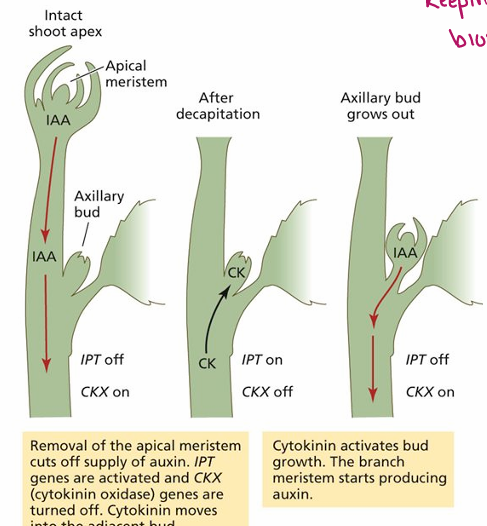
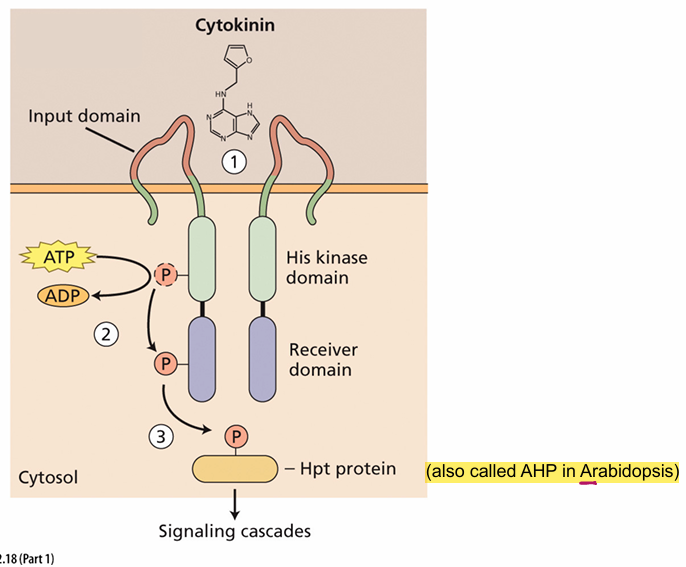
Cytokinin receptors…
plasma membrane/ER
What are ARRs?
Arabidopsis Response Regulators
Type-B ARR: positive regulators of CK response (positive)
type-A ARR: negative regulator of CK response (negative)
shuts down transcription pathway
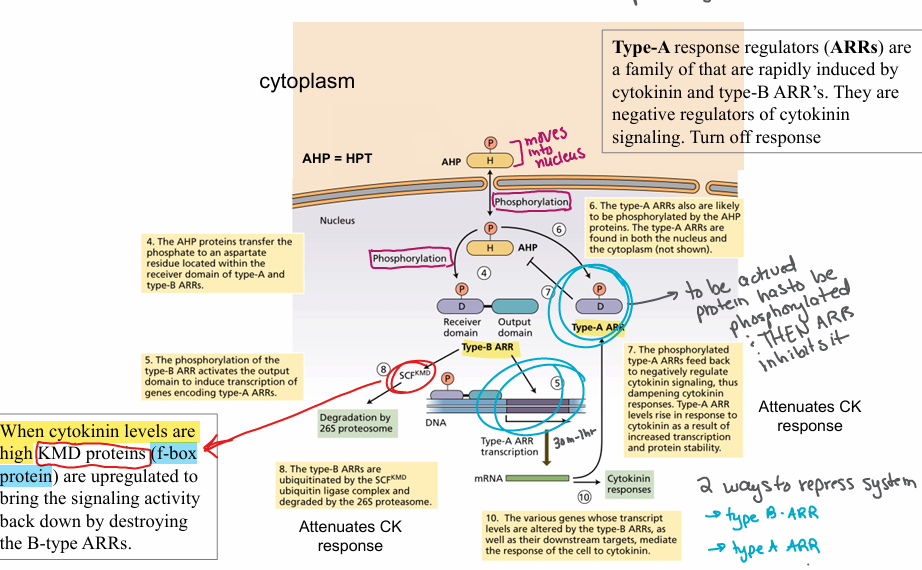
How were gibberellins discovered?
Foolish seedling disease- severe mutation caused plants to fall over into water and die
japan late 1890s
gibberellin characteristics
4 ringed structures (biosynthesis starts in plastid and ends in cytosol)
numbered in order of discovery (many intermediates)
made is various tissues (plastids associated)
transport primarily through phloem
What is the the Role Of Gibberellins In Plant Development?
1. Seed germination-discuss specifics later in semester
2. Promotes phase changes: juvenile to adult morphology
• GA is especially important in leaf morphology changes (shape/arrangement)
Promotes stem elongation and flowering in some plants
flowering requires long day to grow
pollen development/complete development in seeds/fruit
not enough GA= seed development is effected
What is bolting?
growth of flowering stock
induced by gibberellin
stimulates internode elongation
Describe the molecular Mechanism for GA responses
DELLA: repressor protein
PIF3/4: Transcription Factors for GA mediated growth and development
SCF complex (SCFSLY1)
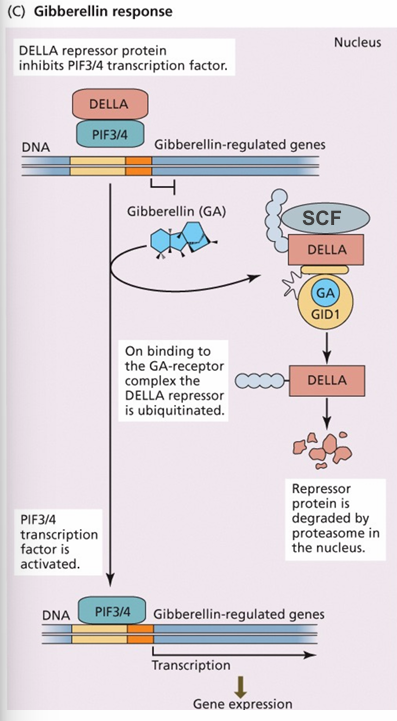
Abscission means…
the shedding of various parts of an organism
Abscisic acid
ABA promotes synthesis of the plant growth hormone ethylene
ethylene is actually responsible for abscission
ABA plays an important role in bud dormancy
all cell with a plastid can synthesize ABA… transported in xylem
Abscisic acid functions
Primary function is as a growth inhibitor
• negative regulator of growth (dormancy in seeds & buds)
2. Stress hormone
response to drying, cold temps, salt change
3. Can respond to some pathogens and promote plant defenses
Abscisic acid can regulate…
gene transcription
ABA Receptor Kinase (SnRK2):
• phosphorylates itself and ABA transcription factors (ABF)
• ABFs bind to promoter elements & initiate transcription of ABA inducible genes
Abscisic acid can mediate…
ion channel activity
guard cell closing
ABA Synthesized in root, transported in transpiration stream
• Enters guard cells
• SnRK2 kinase can phosphorylate and activates Ion channels that lead to guard cell closure (and prevent water loss)
water follows ion/osmotic gradient
What features are unique to guard cell?
1. Guard Cells are anchored to each other at their “ends”
2. Thickened Walls that face the pore
3. Radial Micellation of cellulose microfibrils (provide rigidity)
guard cells are attached to each other at their tip and have reinforced walls lining the pore